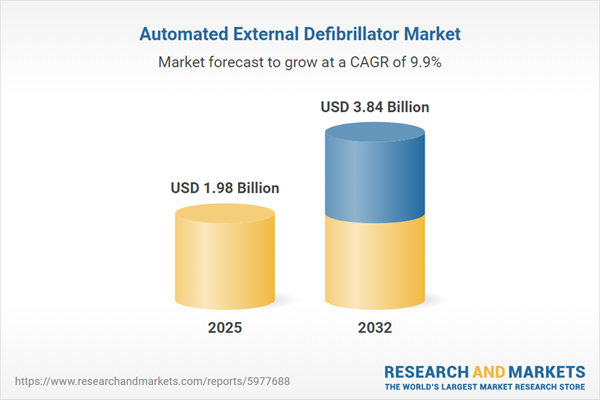Speak directly to the analyst to clarify any post sales queries you may have.
Senior executives face increasing complexity in the automated external defibrillator (AED) market, where evolving compliance obligations, rapid deployment needs, and heightened reliability expectations reshape emergency response strategies. This analysis equips leaders with the frameworks required for precise asset management, procurement efficiency, and readiness planning across multifaceted operational environments.
Market Snapshot: Automated External Defibrillator Market Size and Growth
The automated external defibrillator market is valued at USD 1.80 billion, with forecasts projecting an increase to USD 1.98 billion in 2025 and reaching USD 3.84 billion by 2032, resulting in a compound annual growth rate (CAGR) of 9.92%. Market expansion is led by innovation in device engineering, targeted investments by both public and private stakeholders, and growing access to AED solutions. As organizational priorities shift, procurement approaches and deployment tactics continuously evolve to reflect regulatory, technological, and emergency preparedness trends relevant to healthcare leaders and operational strategists.
Scope & Segmentation: Applying Strategic Insights Across the Automated External Defibrillator Market
This report provides actionable segmentation frameworks to guide AED strategy. Executives gain clarity on structuring procurement, aligning deployment models, and optimizing continuous oversight of assets within varied industry landscapes and organizational structures.
- End User: Home care providers, clinics, hospitals, commercial facilities, public venues, sports organizations, emergency response teams, and transit authorities. Each segment brings specific deployment priorities and compliance considerations shaped by end-user capabilities and operational requirements.
- Distribution Channel: Government tenders, OEM sources, specialty distributors, value-added resellers, digital sales platforms, and third-party distributors. These routes support flexible sourcing and tailored business objectives.
- Product Type: Fully automatic and semi-automatic models meet both highly skilled responders' requirements and facilitate operation by users with minimal experience.
- Battery Type: Alkaline and lithium power solutions enable adaptable maintenance planning and scalable fleet management across distributed sites.
- Application: AED deployments address both planned clinical interventions and rapidly emerging emergency incidents, allowing coverage flexibility.
- Portability: Portable and wearable designs ensure AEDs are accessible in mobile settings or areas with heavy foot traffic.
- Price Range: Options across high, medium, and low price points allow organizations to match purchasing strategies with budgets and growth objectives.
- Regional Coverage: North America, Latin America, Europe, Middle East, Africa, and Asia-Pacific. Each market presents unique regulatory requirements, distinct adoption rates, and evolving operational preferences.
- Featured Companies: Industry leaders such as Koninklijke Philips N.V., ZOLL Medical, Stryker, Nihon Kohden, Cardiac Science, HeartSine Technologies, Defibtech, Shenzhen Mindray, Schiller AG, and Laerdal Medical AS foster market continuity by defining technology standards.
Key Takeaways for Senior Decision-Makers
- Integrating AEDs throughout clinical and non-clinical environments encourages the adoption of universal training, enabling effective response across all organizational levels and community groups.
- Investing in models with features such as remote monitoring and onboard prompts strengthens regulatory compliance as well as data tracking requirements.
- Diversification of procurement pathways, including digital and physical channels, improves adaptability to fluctuating supply chain conditions or shifting regulatory frameworks.
- Customizing asset portfolios by selecting technical features, battery types, and specific support programs drives greater device reliability and enables seamless management across facilities.
- Flexible approaches to acquisition and deployment secure business continuity during expansion or when encountering supply disruptions.
- Tailoring AED strategies to align with local and regional regulatory demands elevates risk mitigation and overall emergency program effectiveness.
Tariff Impact: Sourcing and Supply Chain Resilience in the AED Sector
Recent changes in tariffs affecting AED devices and components necessitate new sourcing and inventory management approaches. By expanding supplier networks, assessing nearshoring options, and optimizing geographically distributed inventories, organizations reinforce procurement stability and shield operations from regulatory and trade uncertainties.
Methodology & Data Sources
This research draws on direct interviews with leaders in procurement, operations, and supply chain roles across the sector. Data includes network mapping and in-depth regulatory review, supporting insights that guide practical and robust AED management decisions at all organizational levels.
Why This Report Matters for Automated External Defibrillator Market Stakeholders
- Empowers executive teams to anticipate technology innovation, manage regulatory complexities, and diminish operational risk in global AED strategies.
- Delivers detailed segmentation and practical guidance, enabling sustainable program execution and rapid decision-making for multisite deployment.
- Encourages adherence to compliance best practices and comprehensive oversight to ensure continuous program performance and business resilience.
Conclusion
By leveraging adaptive sourcing models and robust oversight, decision-makers secure operational agility and maintain compliance in an evolving emergency response landscape. Strategic deployment planning ensures readiness for both current and emerging challenges.
Additional Product Information:
- Purchase of this report includes 1 year online access with quarterly updates.
- This report can be updated on request. Please contact our Customer Experience team using the Ask a Question widget on our website.
Table of Contents
3. Executive Summary
4. Market Overview
7. Cumulative Impact of Artificial Intelligence 2025
Companies Mentioned
The companies profiled in this Automated External Defibrillator market report include:- Koninklijke Philips N.V.
- ZOLL Medical Corporation
- Stryker Corporation
- Nihon Kohden Corporation
- Cardiac Science Corporation
- HeartSine Technologies, Ltd.
- Defibtech LLC
- Shenzhen Mindray Bio-Medical Electronics Co., Ltd.
- Schiller AG
- Laerdal Medical AS
Table Information
| Report Attribute | Details |
|---|---|
| No. of Pages | 196 |
| Published | October 2025 |
| Forecast Period | 2025 - 2032 |
| Estimated Market Value ( USD | $ 1.98 Billion |
| Forecasted Market Value ( USD | $ 3.84 Billion |
| Compound Annual Growth Rate | 9.9% |
| Regions Covered | Global |
| No. of Companies Mentioned | 11 |









